April 2011
Monthly Archive
April 25, 2011
Ref:- The Permanent Way of the Great Western Railway for Gun Street depot (part 2)
Ref:- Quirky Answers – GWR PW Chairs
Many years ago I was asked to collect a “package” for a fellow S7 modeller… he had won an E-bay auction and the buyer had requested collection for the “package” weighed around 90-100 lbs.. When my friend called to collect his “purchase” I was shown what I had collected – two cast iron rail chairs. One of the chairs was from the L&NWR and has no relevance to this journal. The second chair was from the Great Western Railway and my friend suggested that I might like to retain the item and that is how I came to be the custodian of a (very) small part of GWR history.
I have tripped / fallen over the GWR chair so many times in the last few years without giving any thought as to the part which it might play in the alternative world of Basilica Fields… and ‘Quirky Queries’ owes its inclusion in this journal to yet another encounter between my toes and that immovable object. Some weeks after the Permanent Way of the Great Western Railway for Gun Street depot (part 1) was written I came across the chair again and this time the lettering on the base attracted my attention. There are several collections of railway chairs at different “heritage / preservation” centres and most of those chairs have raised letters / numbers on the top surface of the base. In general, the letters /numbers give information about the relevant railway company, where and when the chair was cast plus an indication of the chair type (for example:- plain line chair, switch chair, crossing chair… ). However, this chair does not conform to the norm for the only markings on the chair are “GWR” and “86”, markings which appear to have been recessed into the casting.
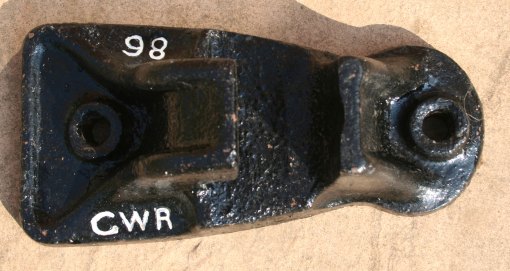
GWR rail chair - top view

GWR chair - three quarter view
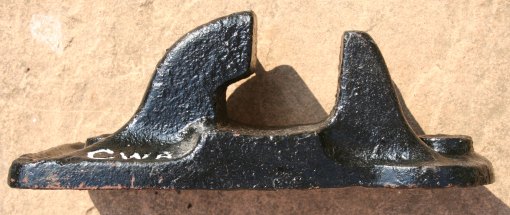
GWR rail chair - side view
Now it is possible that the chair dates from a time when the “normal” expected details were not included on the casting. However, the general size and shape of this chair suggests that it pre-dates the style of chair shown in the drawings of the Permanent Way of the Great Western Railway for Gun Street depot (page 2).
So, do the photos show a rail chair for the 86lbs per yard rail which was instroduced in 1882?
What do you think?
regards, Graham
[further information on this type of chair has been found and the topic is now continuing as a Quirky Answer ]
April 23, 2011
Part 1 of this topic introduced the background to the permanent way of the Great Western depot at Gun Street by way of a summary of primary sources and an indication of the type of track to be found in the sidings of the depot. This post expands upon the summary of part 1 by describing the PW and the Switch and Crossing fittings and by including some relevant drawings from the GWR Engineering Society pamphlet “Some Notes on Permanent Way” (Harvie 1898).
To recap; the Gun Street depot was opened circa 1880 and at that date the permanent way of the Great Western “narrow gauge” could, maybe unkindly, be described as ‘lightweight’ with rails of 86lbs per yard (Bowler 1923). The damp and acidic atmosphere in the Metropolitan Railway tunnels caused excessive corrosion and wear of the rails, in some locations the track deteriorated so quickly that the Metropolitan Railway replaced the rails every 2 to 3 years. Whilst traffic over the Inner Circle Extension was far greater than the traffic in Gun Street depot, the rail conditions were such that the shunting engines slipped frequently, and as a result the GWR had to replace the rails more than once in the 1880s and 1890s.
The GWR increased rail strength progressively with a rail of 92lbs per yard section in 1894, a 95lbs rail in 1897 and a 97 1/2 lbs rail in 1900. Apart from an increase in the width and depth of the rail foot from 86lbs rails to 92lbs rails, the sections of the 92lbs, 95lbs and 97 1/2 lbs rails are very similar and difficult to distinguish in photographs. By the mid 1890s the original 86lbs rails in the Gun Street depot had been replaced by a stronger rail and the change in the dimensions of the rail foot dictated that the chairs (and sleepers) were replaced at the same time. By the mid 1890s the permanent way had been re-laid from the formation upwards and reflected contemporary GWR PW practice.
GWR plain track of the mid-1890s used 32ft rails of 92lbs per yard carried in cast iron chairs with 12 sleepers per rail length, except where the formation was soft, then an extra sleeper per rail length was introduced. Much of the ground in the vicinity of the the Inner Circle Extension, including Gun Street, was old marsh land, so naturally the GWR used 13 sleepers per 32ft rail throughout the sidings. Standard sleepers were 9ft long, of 10in x 5in section and made of Baltic redwood fir, the sleepers were treated with creosote before the chairs were fixed by fang bolts. The arrangement of a plain track panel with 32ft rails is shown below.
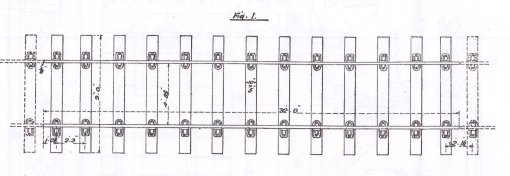
Sleeper spacing for plain track with 32ft rails and 13 sleepers, circa 1895
The GWR standard plain chair of the period was of cast iron and weighed circa 46lbs. Keys to retain the rail in the chair were made of oak or teak… and handed. A drawing of the standard chair, with fang bolts, nuts and washers, is shown below.

Standard chair for plain track, 92lbs and 95lbs rail, circa 1895
The arrangement of the common crossing for simple turnouts requires special chairs and fittings to hold the crossing vee and wing rails in alignment. The GWR had a range of special chairs for the various crossing angles and each chair type was used at a specific position relative to the crossing nose. In the 1890s those chairs were referred to as the 1C, 2C… 6C chairs although nomenclature changed later. At this time the chair under the crossing nose, referenced here as the 3C chair, was a casting – the nose of the vee slid into the casting and was retained by a vertical bolt through an extension of the nose. Some of the special chair types are shown below.

Arrangement of common crossing showing special chairs, distance pieces and blocking pieces
As with the range of common crossings with different crossing angles the GWR had a range of switches of different lengths. The switch rails varied in length according to the radius of the turnout… the greater the radius the longer the switch. In the period of Basilica Fields the switch blades were available in lengths from 9ft up to 20ft where the length is measured from the tip of the switch to the point at which the switch rail has attained the “4 1/2in offset” from the stock rail – the switch rail extends for 2ft beyond the “4 1/2″ offset” and the extra length is supported in the heel chair. The switches of a simple turnout are shown below.
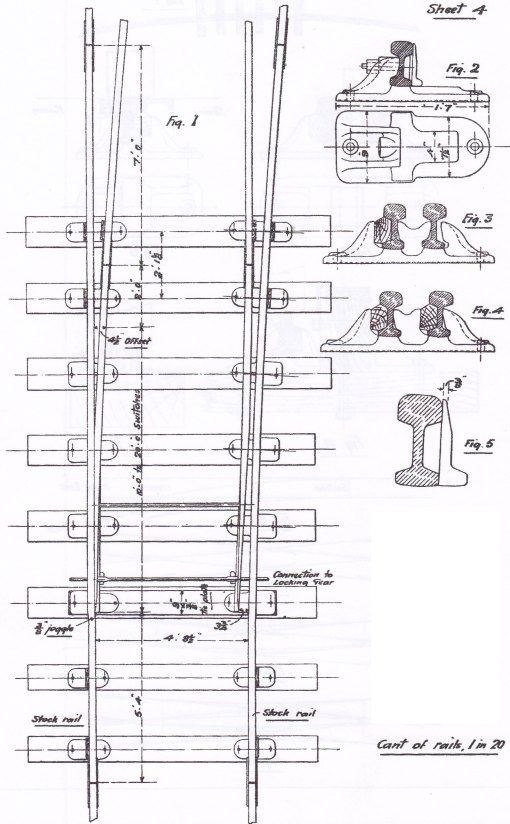
Arrangement of switches showing switch rails, slide chairs and heel chairs
The next part of this topic is to cover the construction of some plain track for the sidings and the catch point where the sidings join the Inner Circle Extension of the Metropolitan ‘Main Line’.
After publishing the first version of this post, and subsequent to the comment from Alan Woodward, I have been able to photograph an example of a chair as shown in Harvie’ s paper (drawing sheet 1, fig. 4 – illustrated above). Of interest given the comments on this post and on a recent Quirky Query is that the chair has recessed characters and the number “68” (which may refer to the “68d section”, 86lbs per yard, which was introduced in 1882).
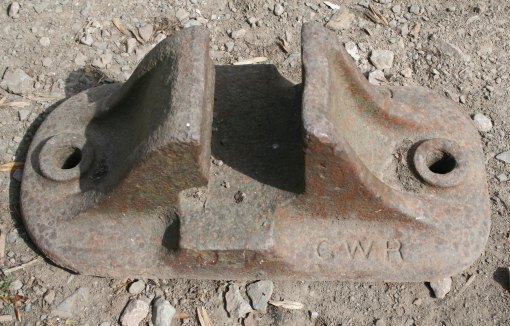
GWR Chair similar to Harvie fig.4 showing "GWR"
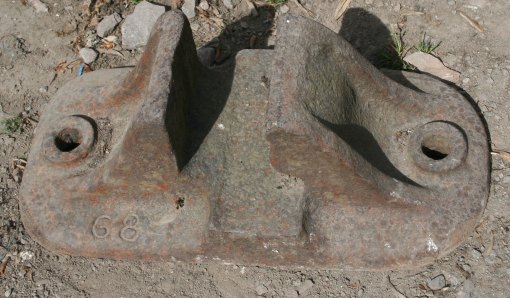
GWR Chair similar to Harvie fig.4 showing "68"
April 21, 2011
reference:- Great Northern Railway 4-wheel Coaches
Adrian’s posts on Great Northern Railway coaches for services over the Extended Widened Lines have indicated that there is dearth of “official” material on the 4-wheel stock (for ‘official’ read ‘primary’). Occasionally we find that a prototype, in which we have some interest, has been covered in the railway press, either full-size as in the GWR Engineering Society pamphlets or model press as in the series of books describing the GWR Goods Services. In the case of these GNR coaches there are some relevant entries in “An Index to Railway Model Drawings” (S.A.Leleux, Oakwood Press, 1972), viz:-
Model Railway Constructor
1938, pg.255, pg.314
1940, pg.45
Model Railway News
1956, pg.189
Over to our readers at this point… please contact Adrian or myself if you have access to any of those issues.
Thank you, Graham
April 21, 2011
Today is revealed another part of the Basilica Fields story; a small corner of questions, puzzles and conundrums which have arisen during our researches into the prototype whilst joining up the dots of Adrian’s alternative world. If it helps, consider Quirky Queries as a visit to an Antiques Roadshow event just after the presenters have gone to lunch… lots of interesting objet d’art to discuss and no explanations forthcoming. In truth, Quirky Queries may be just a name on the bottom drawer of a filing cabinet where an unfinished thread dillies and dangles whilst we delve for the light at the end of the tunnel….
For those who have followed the Basilica Fields journal over the last fifteen months or so then you may have noted the occasional Quirky Query in some of our earlier posts… for example: Why did the GWR send examples of the ‘633’ class with condensing gear to Wales whilst at the same time requiring condensing engines for the goods service to Smithfield Market?
So make this part of the Basilica Fields journal your space, where your contributions provide the answers to our questions and you shed light on our confusion.
Thank you and please continue to add to history.
Graham Beare
April 17, 2011
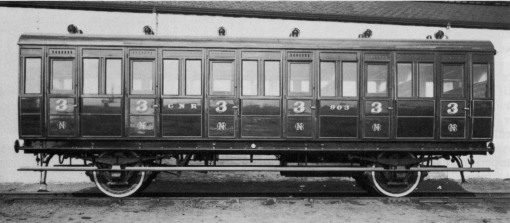
Last April (was it really a year ago?) I remarked that there was a dearth of information for GNR close-coupled 4-wheel suburban coaching stock suitable for Basilica Fields. Despite my recent lack of updates to the blog due to ongoing events, progress on Basilica Fields continues to be made – albeit (mostly) not by me!
Late last year I made a couple of contacts through the GNR Society, and my subsequent bombardment of questions led to an interesting flurry of emails, and, although the situation is still not totally clear at present, it looks as though a big step has been made towards eventually facilitating the building of necessary stock required for those services, and the acquisition of some drawings.
Graham Beare has also been hard at work scouring accident reports instigated by the Board of Trade, and sending me relevant information, the best of which, so far, divulges the classification and running numbers of a twelve carriage close-coupled set running between Potters Bar and Kings Cross in 1898.
So, for the record, hauled by 120 Class No.515, the train in question consisted of :
Brake 3rd no.248, 3rd no.1636, 2nd no.1512, 2nd no.1511, 2nd no.1508, 1st no.1534, 1st no.1443, 2nd no.319, 2nd no.1323, 3rd no.1499, 3rd no.1505, Brake 3rd no.399.
Sounds very useful, but not for the first time while delving into the archives for Basilica Fields has an official document contradicted generally approved history; I understand (I’m no GNR historian) that it is usually accepted that the GNR quickly followed the Midland Railway’s lead in the mid 1870s by abolishing 2nd class. However, not only here, both other BoT reports clearly list second class carriages involved in accidents in the London suburban area. No doubt there is a rational explanation…
The photo is of a third class suburban close-coupled ‘Metropolitan’ carriage, no.903, designed by Howlden and built in 1900. These ‘Metropolitan’ carriages were 9′ wide (to cram the hapless commuter in), with half-height compartments and 3″ recessed doors to maintain the lading gauge. Sister carriage no.902, as part of a Muswell Hill – Kings Cross train was involved in a collision at Finsbury Park in 1907.
Of course it’s entirely possible the carriages listed in the 1898 accident are not of the Metropolitan type, and are therefore a red herring. Further updates on these will appear as and when more information comes to light.
Next Page »









